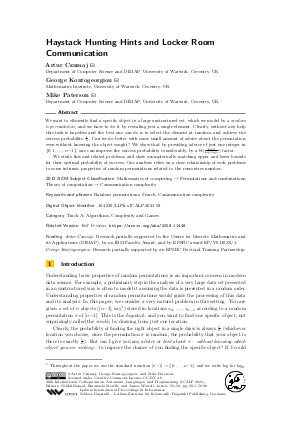Haystack Hunting Hints and Locker Room Communication
Authors Artur Czumaj, George Kontogeorgiou, Mike Paterson
-
Part of:
Volume:
48th International Colloquium on Automata, Languages, and Programming (ICALP 2021)
Part of: Series: Leibniz International Proceedings in Informatics (LIPIcs)
Part of: Conference: International Colloquium on Automata, Languages, and Programming (ICALP) - License:
 Creative Commons Attribution 4.0 International license
Creative Commons Attribution 4.0 International license
- Publication Date: 2021-07-02
File

PDF
LIPIcs.ICALP.2021.58.pdf
- Filesize: 1.61 MB
- 20 pages
Document Identifiers
Related Versions
- Full Version https://arxiv.org/abs/2008.11448
Subject Classification
ACM Subject Classification
- Mathematics of computing → Permutations and combinations
- Theory of computation → Communication complexity
Keywords
- Random permutations
- Search
- Communication complexity
Metrics
- Access Statistics
-
Total Accesses (updated on a weekly basis)
0Document
0Metadata
Abstract
We want to efficiently find a specific object in a large unstructured set, which we model by a random n-permutation, and we have to do it by revealing just a single element. Clearly, without any help this task is hopeless and the best one can do is to select the element at random, and achieve the success probability 1/n. Can we do better with some small amount of advice about the permutation, even without knowing the object sought? We show that by providing advice of just one integer in {0,1,… ,n-1}, one can improve the success probability considerably, by a Θ((log n)/(log log n)) factor.
We study this and related problems, and show asymptotically matching upper and lower bounds for their optimal probability of success. Our analysis relies on a close relationship of such problems to some intrinsic properties of random permutations related to the rencontres number.
Cite As Get BibTex
Artur Czumaj, George Kontogeorgiou, and Mike Paterson. Haystack Hunting Hints and Locker Room Communication. In 48th International Colloquium on Automata, Languages, and Programming (ICALP 2021). Leibniz International Proceedings in Informatics (LIPIcs), Volume 198, pp. 58:1-58:20, Schloss Dagstuhl – Leibniz-Zentrum für Informatik (2021)
https://doi.org/10.4230/LIPIcs.ICALP.2021.58
BibTex
@InProceedings{czumaj_et_al:LIPIcs.ICALP.2021.58,
author = {Czumaj, Artur and Kontogeorgiou, George and Paterson, Mike},
title = {{Haystack Hunting Hints and Locker Room Communication}},
booktitle = {48th International Colloquium on Automata, Languages, and Programming (ICALP 2021)},
pages = {58:1--58:20},
series = {Leibniz International Proceedings in Informatics (LIPIcs)},
ISBN = {978-3-95977-195-5},
ISSN = {1868-8969},
year = {2021},
volume = {198},
editor = {Bansal, Nikhil and Merelli, Emanuela and Worrell, James},
publisher = {Schloss Dagstuhl -- Leibniz-Zentrum f{\"u}r Informatik},
address = {Dagstuhl, Germany},
URL = {https://drops.dagstuhl.de/entities/document/10.4230/LIPIcs.ICALP.2021.58},
URN = {urn:nbn:de:0030-drops-141270},
doi = {10.4230/LIPIcs.ICALP.2021.58},
annote = {Keywords: Random permutations, Search, Communication complexity}
}
Author Details
Funding
- Czumaj, Artur: Research partially supported by the Centre for Discrete Mathematics and its Applications (DIMAP), by an IBM Faculty Award, and by EPSRC award EP/V01305X/1.
- Kontogeorgiou, George: Research partially supported by an EPSRC Doctoral Training Partnership.
References
-
Micah Adler, Soumen Chakrabarti, Michael Mitzenmacher, and Lars Eilstrup Rasmussen. Parallel randomized load balancing. In Proceedings of the 27th Annual ACM Symposium on Theory of Computing (STOC), pages 238-247, 1995.

-
Béla Bollobás. Random Graphs. Cambridge University Press, Cambridge, UK, 2nd edition, 2001.

-
Carlo Emilio Bonferroni. Teoria statistica delle classi e calcolo delle probabilità. Pubblicazioni del R Istituto Superiore di Scienze Economiche e Commerciali di Firenze, 8:3-62, 1936.

-
Joe P. Buhler. Hat tricks. The Mathematical Intelligencer, 24(4):44-49, 2002.

-
Eucene Curtin and Max Warshauer. The locker puzzle. The Mathematical Intelligencer, 28(1):28-31, March 2006.

-
Devdatt P. Dubhashi and Desh Ranjan. Balls and bins: A study in negative dependence. Random Structures and Algorithms, 13(2):99-124, 1998.

-
Anna Gál and Peter Bro Miltersen. The cell probe complexity of succinct data structures. In Proceedings of the 30th Annual International Colloquium on Automata, Languages and Programming (ICALP), pages 332-344, 2003.

-
Navin Goyal and Michael E. Saks. A parallel search game. Random Structures and Algorithms, 27(2):227-234, 2005.

-
Ronald L. Graham, Donald E. Knuth, and Oren Patashnik. Concrete Mathematics: A Foundation for Computer Science. Addison-Wesley, Reading, MA, 2nd edition, 1994.

-
Donald E. Knuth. The Art of Computer Programming: Sorting and Searching, volume III. Addison-Wesley, Reading, MA, 2nd edition, 1998.

-
Michael Mitzenmacher and Eli Upfal. Probability and Computing: Randomized and Probabilistic Techniques in Algorithms and Data Analysis. Cambridge University Press, Cambridge, UK, 2nd edition, 2017.

-
Martin Raab and Angelika Steger. "Balls into bins" - A simple and tight analysis. In Proceedings of the 2nd International Workshop on Randomization and Approximation Techniques in Computer Science (RANDOM), pages 159-170, 1998.

-
John Riordan. An Introduction to Combinatorial Analysis. John Wiley & Sons, Inc., New York, NY, 1958.

-
Peter Winkler. Names in boxes puzzle. College Mathematics Journal, 37(4):260, 285, 289, September 2006.

-
Peter Winkler. Mathematical Mind-Benders. A K Peters, Ltd., Wellesley, MA, 2007.

